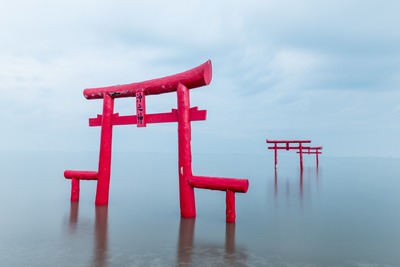Saga
Seven kettles


Nanatsugama, designated as a national natural monument, is a scenic spot formed by the erosion of basalt exposed to the rough waves of the Genkai Sea, known for its roughness. The cliffs are deeply gouged, and as the name suggests, seven caves stand side by side, reminding us of the wonders of nature. The rock surfaces, which are arranged in regular columns, are called columnar joints, which are caused by the contraction of lava as it cools and hardens. The largest hole has a frontage of 3 m and a depth of 110 m. If wave conditions are favorable, a sightseeing boat can take visitors inside. The top of Nanatsugama is a grassy plain with an observatory and a promenade that attracts many tourists. The area around Nanatsugama is also a popular fishing spot for anglers. At the northern end of the cape. There is a tradition that this is the place where Empress Jingu threw away earthenware when praying for victory in the Korean War, and there is a shrine dedicated to her, Dojikizaki Shrine.
Underwater Torii and Underwater Road


Torii gate in the sea of fantastic scenery
There are three underwater torii gates in the Ariake Sea in Sakae-cho, Tara Town. It is said that about 300 years ago (around 1693), a deputy marooned on the island was saved by a large fish. The deputy was so impressed that he built “O-o Shrine” named after the fish, and also built a torii gate in the sea about 2 chou (about 200 meters) from the shore. This torii gate is the gate between the island and Okinoshima Island, and the tradition of building a new gate every 30 years has been handed down to this day. It is a popular photo spot.
Yoshinogari Historical Park


The Yoshinogari Site is Japan’s largest Yayoi Period (4th century B.C. – 3rd century A.D.) dugout settlement site, spanning Kanzaki City and Yoshinogari Town and surrounded by a 2.5 km-long dugout. The site has been excavated to reveal the remains of numerous dwellings from all periods of the Yayoi period, stilted warehouses, over 3,000 tortoise coffins, and tombs thought to have been the tombs of kings in the middle Yayoi period. From the tombs, highly skilled artifacts such as bronze swords and glass tubular beads were excavated, suggesting exchange with the Chinese mainland and the Korean peninsula.
Forest of Environmental Art


A fantastic “healing” photo spot. Located halfway up Mt. Sakure, the “Maple Forest” was built over a period of about 40 years. Visitors can enjoy the spectacular view of nature throughout the four seasons, with fresh greenery in spring and more than 10,000 maple trees in autumn.
